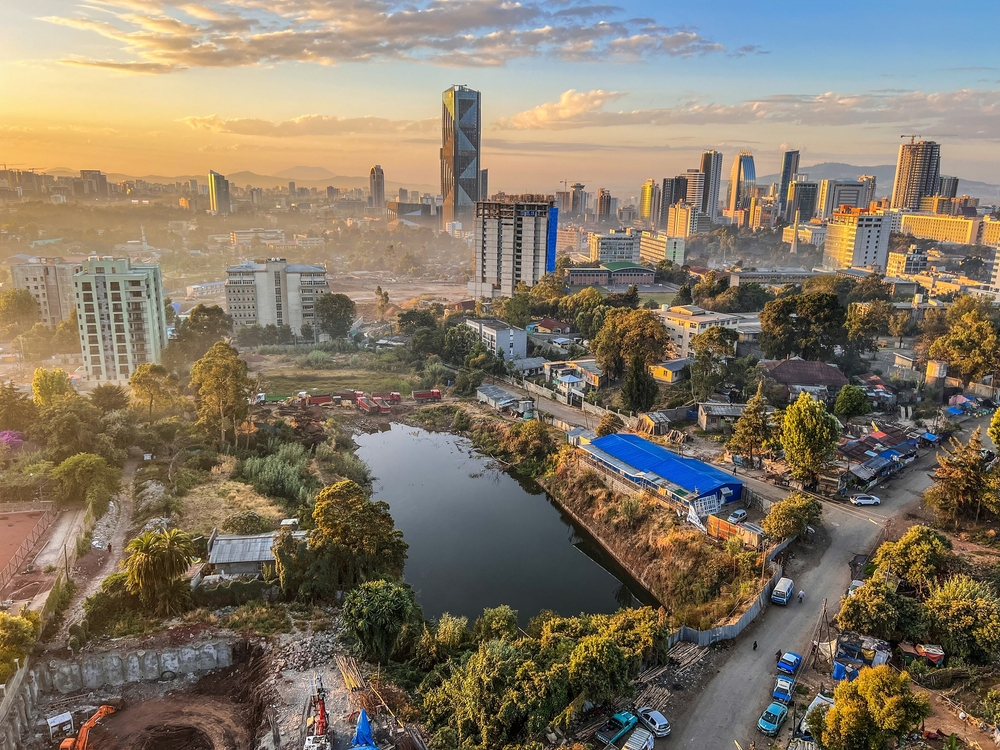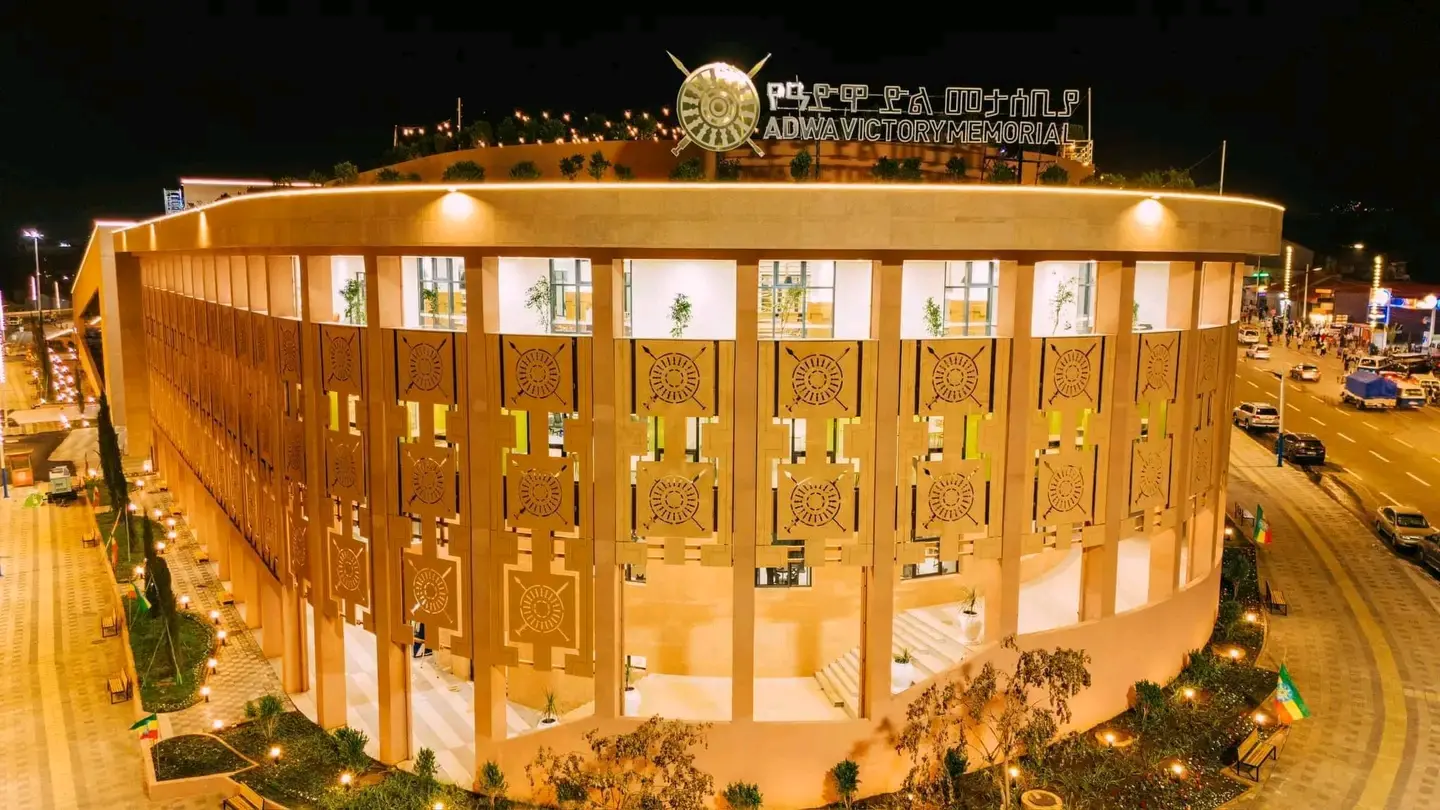

Africa's capital, Addis Abeba is a hub of economic, social, and political activity, as well as the headquarters of the African Union and the United Nations Economic Commission for Africa. There are a number of galleries, parks, monuments, churches, markets, mosques, and museums including the Ethiopian National Museum, which holds the fossilized bones of Lucy, the Australopithecus.
The monument represents Emperor Menelik's anti-colonial fight, which culminated in the Conflict of Adrightwa, the culminating battle of the First Italo-Ethiopian War in 1896, and is watching Africa's triumph over European colonization. Queen Zewditu, Emperor Menelik II's daughter, orders that it be built in remembrance of her father.
The Lion of Judah, erected in the square of Addis Ababa Railway Station, depicts Emperor Menelik's devotion to connecting Ethiopia with the outside world through the railway, and the statue is carved in relief with the faces of four high-ranking personalities: Emperor Menelik II, Queen Zewditu, Ras Mekonnen, and Negus Teferi.
Emperor Haileselassie dedicated the monument to the Ethiopians who bravely battled and defeated the Italian fascist invaders.
A monument was created in honor of members of the valiant Ethiopian defense forces who repelled the invading Somali army headed by President Siad Bare's invasion of Eastern Ethiopia.
An assassination attempt on Viceroy Graziani in February 1937 by two Ethiopians, Abrha Deboch and Moges Asgedom, prompted the Italians to launch a three-day reign of terror.
It was dedicated by Emperor Haile Selassie in commemoration of Abune Petros, the archbishop of the Ethiopian Orthodox church who aided national patriots in their fight against fascist Italian invaders.
The site of stone tools and fossils, the most renowned of which are the bones of Lucy, or "Denkenesh," a 3.5 million year old female skeleton.
This was formed in October 1986 to commemorate the hundredth anniversary of Addis Ababa's founding as a capital city. It was the previous home of Ras Birru, a prestigious Dejazmatch in Menelik's court.
Thousands of young people were killed extrajudicially by the Derge in reaction to their democratic aspirations.
It was once known as Genete Leul Palace, and it is now the main university building. It is one of the early modern palaces erected in the mid 1930s and functioned as a central palace until 1960.
One of Addis Ababa's most magnificent cathedrals, commissioned by Emperor Menelik II to celebrate his astounding 1896 victory against the Italians in Adwa, and dedicated to St George (Ethiopia's patron saint), whose image was brought into the war
Addis Ababa's Nur Mosque is a Muslim temple. This mosque is the city's oldest Islamic temple. It was recently reconstructed. The mosque was designed to depict the magnificence of Islamic architecture, with distinctive domes, towers, and piers. The original modest structure dates from the late nineteenth century and was the first mosque erected in Addis Abeba's new town.
The most significant Islamic religious center in the world. It is located near the Merkato market. It is Addis Abeba's most visited mosque.
The Mercato in Addis Abeba is a thrill of a market, and while it's one of the most hectic areas in Addis Abeba, there's beauty wherever you turn. Africa's largest market, a sprawling open-air bazaar that stretches for kilometers. Many individuals will be holding massive objects on their heads at the same time. Trucks and vans usually halt on the streets, and the loads of items are pushed into the market's interior muddy passageways by a human porter or a donkey. Mercato is one of those markets where you can find anything. Strolling around the marketplaces, catching whiffs of various other aromas, you'll suddenly find yourself walking and a wave of Ethiopian spice will strike your nose. Shola Market is one of Addis Abeba's top local markets for experiencing traditional commerce. It is less congested than Merkato and is the ideal market for purchasing spices, bedding, gold and antiquities, traditional textiles, coffee pots, and some furniture.
The lush forest on the mountain acts as the "lung of Addis Ababa," regulating the city's temperature. Entoto Natural Park is a one-of-a-kind site to explore the largest primeval mountain area, with streams running out of pristine springs and waterfalls, and it marvels with absolutely beautifully spectacular spots to unwind. In the 1800s, Emperor Menelik used Entoto Mountain as a castle and royal court. Later, the Ethiopian Prime Minister established the Entoto Natural Park in Addis Ababa as a tourist attraction. The park is a one-of-a-kind natural sight in a highland setting for relaxation and pleasure. It is located on the outskirts of Addis Ababa, at an elevation of 2600 to 3200 meters.The park is ideal for families or groups of friends who want to cook their own meals and stay in a tented camp.
The Ethiopian Unity Park is located inside the grounds of the National Grand Palace. During his reign, Ethiopian Emperor Menelik II erected the National Grand Palace on 40,000 square meters of land. Since then, the palace has functioned as a residence for Ethiopia's leaders. Ethiopia's Unity Park combines natural, cultural, historical, and heritage tourism features. Unity Park's distinctive natural features include zoos with 37 mammals, nine different sorts of animals, including Giraffes, Zebras, Kudu, Impala, Eland, Gemsbok, Nyala, Wildebeest, and White Rhino, thirteen different types of water creatures, and indigenous diverse birds in the aviary.
Historical relics demonstrate not only the presence of things in a Palace, but also the degree of an ancient society. None of the palace's items were commonplace. Everything, however, was made of gold, from the king's throne to modest restaurant supplies. Sculptures across the park show Ethiopian ethnicities' culture, civilisation, and power. Wood, stone, and mud are used to create sculptures. Furthermore, the handcrafted sculptures depict Ethiopian treasures.
Dr. Abiy Ahmed, Ethiopia's Prime Minister, inaugurated Sheger Park. The Park is part of the 58-kilometer-long Entoto-Akaki Riverside Beautification Project in Addis Abeba. It was created in an attempt to make Addis Abeba the "new flower," as the name implies. Sheger's establishment is intended to boost tourism in Addis Abeba, Africa's political capital. Addis Abeba is a city that is always worth visiting since it is a superb example of urban tourism. You will undoubtedly love the numerous recreation facilities, which include cultural centers, art galleries, science and technology institutes, tennis courts, and a waterfall café. The Park is always serene, pleasant, and an excellent location to read. You may also take the stone route down the hill. One can see that Sheger is an excellent presentation of the numerous Ethiopian cultures, offering various forms of entertainment to guests of all ages.
Addis Ababa has a lot of excellent art galleries. Local artists have flourished in Addis, and the city sponsors art exhibitions. You will appreciate visiting various art galleries. In a few years, photography in the city has likewise raised its creative threshold, sharing the art scene with an amazing body of work by local photographers. Prepare to be wowed by Addis Fine Art, St. George's Gallery, Gebre Kristos Desta Centre, Zoma Museum Mekanisa, and Makush Art Gallery & Italian Restaurant, among many more.
Ethiopia provides a broad variety of delectable meals, and you will have the opportunity to sample everything from aromatic coffee to 'injera' flatbread.

Our tour begins at the Travel Ethiopia office where the vehicles will be waiting for you to start your Adwa Memorial Museum and Coffee process tour at 09:00 am we will depart to the Adwa Museum in Piassa.
You will visit the Adwa Museum, recently inaugurated in February 2024. Adwa Museum, situated in the heart of Addis Ababa's Piassa, stands as a magnificent tribute to the Ethiopian victory at the Battle of Adwa. This grand complex not only houses a museum, but also encompasses commercial spaces, meeting halls, and recreational areas.
Dedicated to commemorating the Ethiopian heroes who fought against Italian colonizers in 1896, the museum showcases historical artifacts, documents, and photographs that narrate the story of the battle and its significance. Visitors can even marvel at the "Tsehay" aircraft, recently repatriated from Italy, alongside weapons and clothing used by the Ethiopian patriots. With its focus on preserving history and fostering national pride, the Adwa Museum serves as a powerful symbol of Ethiopian resilience and a must-visit destination for anyone interested in the country's rich cultural heritage.